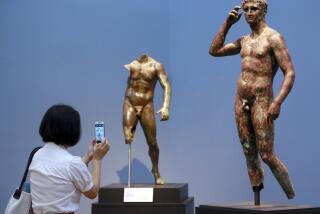Museum Removes Suspect Sculptures From Display
- Share via
The J. Paul Getty Museum removed from display Thursday several pieces of sculpture that fit the description of works an Italian magistrate said may have been smuggled out of Sicily a decade ago.
Two marble heads and associated hands and feet were removed from the museum’s Magna Grecia gallery, according to press officer Lori Starr.
The museum does not own the pieces, Starr said, adding that they have been on loan from a private collector and will be returned to the collector. According to terms of an anonymous loan agreement, the museum cannot reveal the lender’s name, she said.
Earlier this week Italian magistrate Silvio Raffiotta told The Times that he was investigating the theft of Greek sculpture from an archeological site in Morgantina, Sicily, and that he believed pieces of stolen statuary--a face, hands and feet--had turned up in the Getty Museum.
“In view of the specific information provided today by the Los Angeles Times, we have taken the initiative to remove the objects from display and we are making arrangements to return them to the owner,” Starr said.
“No one has presented any evidence to us that they are from Morgantina,” Starr said. However, the museum acted quickly to remove the pieces because they may fit the description of objects allegedly stolen from the Morgantina site.
“Ultimately these matters will have to be settled through formal channels rather than through the press. Any discussion of the possible provenance of these objects should be between their owner and the Italian government,” she added.
The Getty controversy began with allegations that a 5th-Century BC classical Greek statue unveiled by the Getty last month may have been illegally removed from Morgantina in 1979. Graziella Fiorentini, director of antiquities in Agrigento, Sicily, made that suggestion, triggering an investigation by Italian authorities and Interpol.
The Getty’s unveiling of the 7 1/2-foot statue, believed to be that of the Greek goddess Aphrodite, caused a sensation in the art world because the massive statue is said to be the only acrolithic figure that has survived relatively intact from head to foot.
Raffiotta described the allegedly stolen objects as pieces of acrolithic statues. Acrolithic figures, typically made in Greek colonies of Sicily and Southern Italy, are composed of separately carved marble heads, hands and feet attached to limestone or wood bodies.
Raffiotta, the magistrate who is independently investigating thefts from Morgantina, said he does not believe that the Aphrodite was removed from there, but indicated that two other statues from Morgantina were on display at the Getty.
Raffiotta has not asserted that the Getty knew the pieces were stolen.
Scholars believe that the bodies of the acrolithic fragments formerly on view at the Getty were made of wood that has long since rotted away.
Starr declined to speculate on whether the owner of the heads, hands and feet had intended to donate the objects to the museum, but said that the Getty had never considered buying them.
More to Read
The biggest entertainment stories
Get our big stories about Hollywood, film, television, music, arts, culture and more right in your inbox as soon as they publish.
You may occasionally receive promotional content from the Los Angeles Times.










